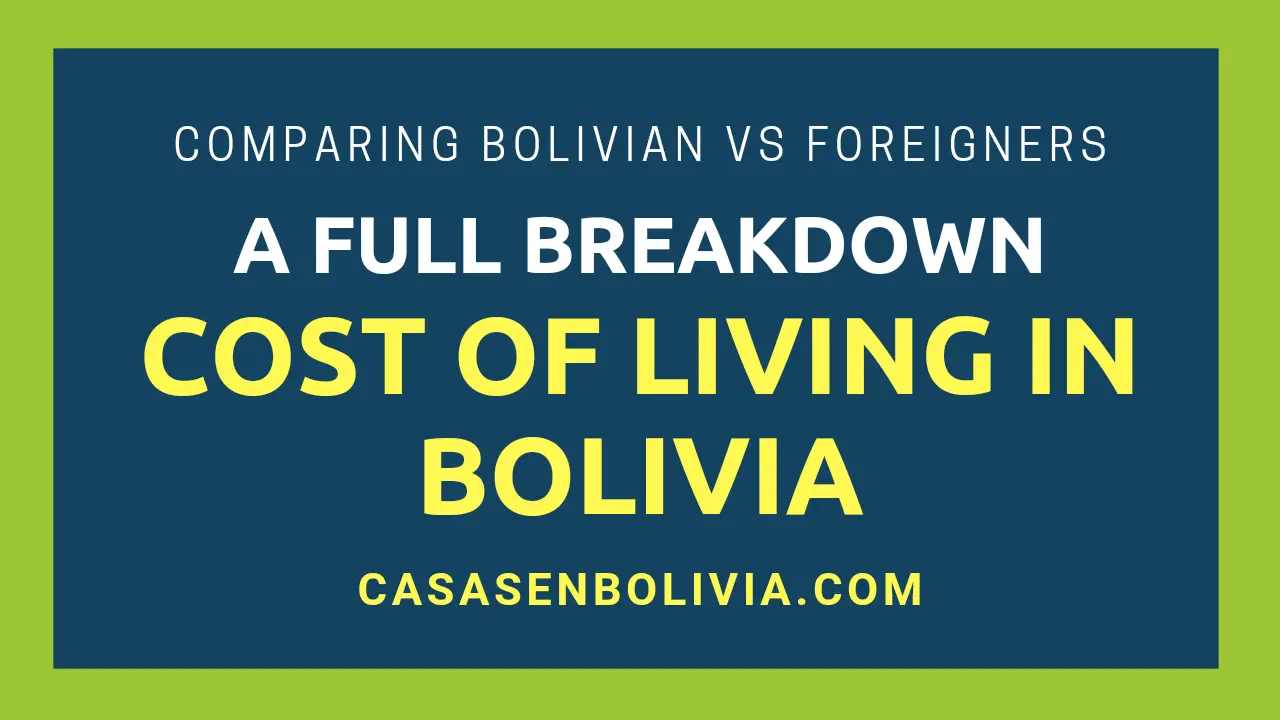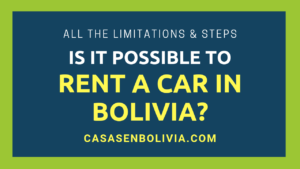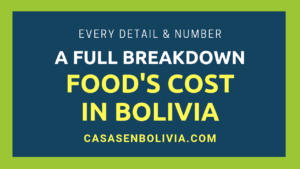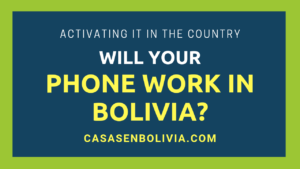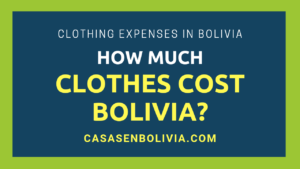Last Updated on February 14, 2025
Living in Bolivia is significantly more affordable than in developed countries. For instance, you can live frugally here, without compromising your health or even your entertainment, for around $500 per person per month. On the other hand, if you desire a lifestyle comparable to that of an upper-middle-class citizen in a developed country, you’ll need to spend around $4,000 per month.
The cost of living in Bolivia for lower- to middle-class Bolivians is approximately $500/month. For upper-middle-class Bolivians, it’s $1,500/month. For wealthy Bolivians, it ranges from $3,000 to $5,000/month. Spending $1,500 per month in Bolivia, akin to an upper-middle-class Bolivian, will provide a lifestyle comparable to that of a developed country.
In this article, we’ll break down the figures associated with the cost of living in Bolivia. We’ll compare Bolivian citizens with foreigners, based on their income levels and accustomed lifestyles. We are real estate and business experts from Bolivia who have lived here our entire lives. Therefore, we know the details. That said, let’s delve into the specifics.
The General Cost of Living in Bolivia
Here, you can see the cost of living in Bolivia categorized by the five social classes that experts typically use when assessing the cost of living in a region or country:
- Lower-class Bolivians. This social class has such a low standard of living that it’s not really comparable to any social class in developed countries (~$250/month per person).
- Lower-middle-class Bolivians. This social class typically achieves a standard of living similar to that of a lower-class citizen in developed countries ($427/month per person).
- Middle-class Bolivians. This social class can be compared to the standard of living of a lower-middle-class citizen in developed countries (~$700/month per person).
- Upper-middle-class Bolivians. This social class is comparable in standard of living to a middle-class citizen in a developed country ($1,490/month per person).
- Wealthy Bolivians. This social class is comparable to the standard of living of an upper-middle-class citizen in a developed country ($5,640/month per person).

Next, we’ll thoroughly examine the cost of living details in Bolivia for three income levels (lower-middle class, upper-middle class, and wealthy Bolivians), *as these are more closely aligned with what you’d find in developed countries* when comparing the cost of living between Bolivia and those nations.
| Bolivian Social Class | Developed Country Equivalent | Cost of Living (1 Bolivian person) | % of Bolivian Population | Standard of Living Achieved |
| Lower-Class Bolivian | Almost non-existent | ~$250/month | 35% | Extreme poverty in developed countries |
| Lower-Middle-Class Bolivian | Lower-Class Citizen | $427/month | 30% | Only most basic needs met |
| Middle-Class Bolivian | Lower-Middle Class Citizen | ~$700/month | 25% | Able to live somewhat decently |
| Upper-Middle-Class Bolivian | Middle-Class Citizen | $1,490/month | 9% | Able to live comfortably |
| Wealthy Bolivian | Upper-Middle Class Citizen | $5,640/month | <1% | Able to live luxuriously |
| (Ultra-Wealthy Bolivian) Almost non-existent | Wealthy Citizen | >$20,000/month | <0.01% | Very few Bolivians reach this class |
For example, a lower-class Bolivian has such a low monthly cost of living and standard of living that they can’t really be compared to any social class in developed countries ($250/month). Also, a middle-class Bolivian ($700/month) can be considered more akin to a lower-middle-class citizen in a developed country, based on their standard of living.
Calculator to Estimate Your Cost of Living in Bolivia
1) Cost of Living in Bolivia for Lower-Middle-Class Citizens
The minimum wage in Bolivia is *around $330 per month*. The government claims this is the minimum amount needed to survive decently in Bolivia, but many people here feel it’s insufficient. We’ll break down the cost of living for an average Bolivian citizen in the following sections.
| Type of Cost (Lower-Middle Class Bolivian) | Monthly Spending |
| Food and Beverages | $70 |
| Housing and Lodging | $150 |
| Apparel & Clothing | $22 |
| Transportation | $50 |
| Medical Care & Health | $30 |
| Entertainment & Recreation | $30 |
| Education & Communication | $25 |
| Other Goods & Services | $50 |
| Total Expenses | $427 |
A) Food and Beverages
Bolivians with low to average incomes ($400 to $600 per month) typically prepare their own meals and rarely dine at expensive restaurants. They almost always purchase their groceries at open-air markets or from wholesale vendors in trucks that come from rural areas. This way, you can find an apple for as little as $0.10 and a banana for $0.05. A reasonably priced, yet satisfying, restaurant meal typically costs $3, including everything.
To purchase all the food and beverages that an average-income Bolivian needs for a month to stay healthy, strong, and comfortable, they’ll spend approximately $70/month.
B) Housing and Lodging
Ordinary Bolivians typically spend between $100 and $300 per month on housing costs. With this amount, they usually obtain a functional living space with one to three bedrooms. Most of the time, these homes or living spaces fall short of the quality you might expect in developed countries, but they at least have all the basic utilities and enough amenities to feel reasonably comfortable.
To secure a one-bedroom apartment with all basic utilities and functionality for comfortable living in a typical neighborhood, a Bolivian needs around $150/month.
C) Apparel and Clothing
Ordinary Bolivians tend to purchase inexpensive, unbranded clothing, often imitations of well-known brands or Bolivian-made apparel. You can find a new jacket for around $10, and despite being unbranded, it offers quality comparable to branded clothing. You can find high-quality shoes for $30 and well-made pants for $10. A decent, unbranded outfit will cost between $50 and $100.
To acquire seven outfits of good-quality but unbranded clothing that will last for two years, a typical Bolivian will spend $525, or around $22/month.
D) Transportation
Ordinary Bolivians typically don’t use taxis or Uber for transportation; they usually rely on public transportation (buses or minibuses) to travel within a city. When traveling between cities or regions, they rarely use airplanes and primarily travel by land. A minibus can charge $0.30 per trip, and a bus $0.20. An intercity one-way trip can cost around $7. People tend to make two or three complete trips within a city per day. Lower- to middle-class Bolivians typically don’t own cars.
To travel throughout the city and make some trips to other regions, a typical lower- to middle-class Bolivian will typically spend around $50/month.
E) Medical Care and Health
Bolivians with average incomes don’t visit the doctor frequently. They are significantly hesitant to undergo medical tests or monitor their health. They don’t spend much on this, and some government health insurance programs are free for most Bolivians. However, when a serious health issue arises, they can spend thousands of dollars on treatment. For a routine consultation, a general practitioner will charge approximately $20.
To cover two routine consultations per year and save for potential minor illnesses, a typical Bolivian will spend $350 per year, or around $30/month. When a major health crisis occurs, such as requiring intensive care, *it can cost $500/day*. A visit to the dentist or ophthalmologist *will cost $20*. A comprehensive health check-up at a private hospital *can cost around $300*.
F) Entertainment and Recreation
Ordinary Bolivians tend to engage in very inexpensive forms of entertainment, such as camping outside the city on weekends, going to the movies, visiting squares or playgrounds with their families, having family gatherings, or simply walking around the small cities. On a typical, entertaining weekend day, they might spend just a few dollars without purchasing anything expensive or participating in extravagant activities.
For activities like going camping, to the cinema, to the park, returning at the end of the day, and perhaps taking a stroll through the streets – a very common routine among ordinary Bolivians – they’ll spend about $15/weekend, or around $30/month (assuming they do this every two weekends).
G) Education and Communication
Average-income Bolivians typically don’t spend anything on education. The government normally covers the costs of primary, secondary, and higher education for lower- and middle-class individuals. However, some middle-class individuals may spend some money on private schools and colleges. A decent private high school can charge $50-$100 per month. Almost all middle-class and lower-income individuals attend Bolivian public colleges.
To cover the costs of books and supplies needed for both high school and college, ordinary Bolivians will spend $300/year, or around $25/month. *Most will attend public schools and colleges, spending $0 per month on tuition.*
H) Other Goods and Services
Typically, lower- and middle-class Bolivians tend to keep the same furniture for decades, until it’s almost unusable. The same applies to bathrooms, kitchens, living room accessories, and other household items. They might spend $5,000 on replacing all of these items within a house every decade. Basic service bills will also be around $10/month for a typical person.
To cover all basic services and replace all furniture and household items every decade, a typical Bolivian will spend around $50/month.
Total Monthly Cost:
A typical Bolivian (lower- to middle-class, or on average, lower-middle class) will spend $427 each month to cover their living expenses. Note that this figure is slightly above the minimum wage in Bolivia, which is currently $310 (2022).
2) Cost of Living in Bolivia for Upper-Middle-Class Bolivians
Now, we’ll examine the details of the cost of living for an upper-middle-class Bolivian ($1,490/month), who typically achieves a standard of living comparable to a middle-class citizen in a developed country.
We won’t delve into the details of the cost of living for a middle-class Bolivian (~$700/month) because it closely overlaps with the behaviors and standard of living of a lower-middle-class Bolivian, as described in the previous section.
| Type of Cost (Upper-Middle Class Bolivian) | Monthly Spending |
| Food and Beverages | $150 |
| Housing and Lodging | $250 |
| Apparel & Clothing | $50 |
| Transportation | $150 |
| Medical Care & Health | $100 |
| Entertainment & Recreation | $350 |
| Education & Communication | $290 |
| Other Goods & Services | $150 |
| Total Expenses | $1,490 |
A) Food and Beverages
Individuals with relatively high incomes in Bolivia (over $1,200 per month) exhibit different behaviors when it comes to purchasing groceries and food. They typically shop at supermarket chains found throughout the cities. *In these stores, food prices are significantly higher* than in open-air markets. People with high incomes also tend to purchase industrially produced and branded foods, including bread, juices, cereals, meat, etc.
To purchase all the groceries, beverages, and food they need in a month, a high-income Bolivian (upper-middle class) will spend around $150/month.
B) Housing and Lodging
High-income Bolivians tend to reside in the central neighborhoods of cities or within apartments in buildings and high-rises. They also tend to settle in specific residential zones and are not dispersed throughout the city. They typically live in modern, high-quality homes or apartments and are willing to spend several hundred dollars on rent.
To secure a one-bedroom apartment that meets their needs, offering a high-quality living space with all the necessary security, functionality, and a premium location, an upper-middle-class Bolivian will spend around $250/month. A mortgage payment would be roughly the same in terms of monthly costs.
C) Apparel and Clothing
Individuals in this income bracket tend to combine branded clothing (approximately $40 for each pair of pants or jacket, ~$60 for shoes) with unbranded clothing, all of high quality. They also tend to purchase some of their clothing in clothing stores rather than open-air markets. Unlike lower- and middle-income individuals, they have a greater variety in their wardrobes, with many outfits for specific occasions, such as meetings, work, exercise, etc. A single outfit can cost around $100.
To acquire approximately 12 outfits suitable for various situations and designed to last for two years, a high-income Bolivian will spend $1,200, or around $50/month.
D) Transportation
High-income individuals in Bolivia tend to use a mix of taxis, buses, and their own cars. Most own a car for their family, typically a family vehicle *rather than individual cars for each person*. These individuals also tend to purchase cars in the $10,000 to $25,000 range, often with bank loans. They also travel more frequently to other locations, primarily by air (approximately $200/round-trip). A taxi ride in Bolivia costs around $3 per trip. Fuel in Bolivia costs around $2 per gallon.
Considering car loan payments, taxi fares, bus fares, air travel costs, and the frequency of travel, an upper-middle-class Bolivian will spend around $150/month to travel throughout the city and make occasional trips to other regions.
E) Medical Care and Health
Regarding health expenses, high-income Bolivians tend to purchase more comprehensive health insurance and, most of the time, opt for private hospitals and doctors. They also undergo routine health check-ups more frequently. Basic health insurance can cost around $500 per year, and full health insurance can reach $1,500 per year. Good private general practitioners typically charge $30 per consultation; dentists and ophthalmologists charge similar fees per session.
To cover four routine consultations per year, save for minor illnesses, and pay for average health insurance, a high-income Bolivian will spend $1,200 per year, or around $100 per month. In private hospitals, intensive care can cost $500/day, and a comprehensive health check-up can cost around $300.
F) Entertainment and Recreation
These individuals also engage in more entertainment activities each month. They travel more frequently to other regions within the country and abroad. They regularly go shopping, attend movies more often, spend money at expensive restaurants, and pursue hobbies that can be costly, such as painting, dance classes, or gym memberships. They also tend to host numerous parties throughout the year.
On a typical day of entertainment or recreation, a high-income Bolivian will spend around $30. A typical party can cost $3,000 to host, and they’ll host one or two per year. Gym access, a painting session, dance courses, and similar activities cost around $30/month each. Considering all of this, a high-income Bolivian will spend around $350/month on entertainment.
G) Education and Communication
Bolivians from the upper-middle class (with relatively high incomes) typically don’t attend public high schools or colleges. *They almost exclusively opt for private education*. A good private high school can cost around $150 per month, and a good college can cost nearly $300 per month. They also tend to take additional classes to learn specialized skills, each of which can cost close to $40 per month.
To cover college tuition and additional courses throughout the year, a high-income Bolivian adult will spend $3,500 per year, or around $290 per month.
H) Other Goods and Services
High-income Bolivians typically spend significantly more on high-quality furniture and other household items. They also tend to have much larger houses or apartments. They’ll spend around $15,000 to replace all furniture and household items every decade. They also consume more basic services and might spend around $25 per person each month to cover them.
To cover all basic services and replace all furniture and household items every decade, an upper-middle-class Bolivian will spend around $150/month.
Total Monthly Cost:
A relatively high-income Bolivian citizen (upper-middle class) will spend $1,490 each month to cover all their living expenses. Note that in Bolivia, we consider an individual to be upper-middle class when they earn more than $1,200 per month.
3) Cost of Living in Bolivia for Wealthy Bolivians
Less than 1% of Bolivians reach this cost-of-living level. They have sufficient income to afford a lifestyle with considerable luxury and comfort, even in Bolivia, which can be compared to how an upper-middle-class citizen lives in a developed country.
However, wealthy Bolivians cannot be compared to wealthy individuals in developed countries. As we just mentioned, they are only comparable to people with relatively high incomes in developed countries. Instead, ultra-wealthy Bolivians, who earn over $20,000 per month, are very rare. In fact, there are likely only a few thousand of them throughout the entire country. Therefore, experiencing a cost of living like an ultra-wealthy Bolivian or a wealthy foreigner is very uncommon.
| Type of Cost (Wealthy Bolivian) | Monthly Spending |
| Food and Beverages | $750 |
| Housing and Lodging | $500 |
| Apparel & Clothing | $300 |
| Transportation | $600 |
| Medical Care & Health | $210 |
| Entertainment & Recreation | $2,300 |
| Education & Communication | $580 |
| Other Goods & Services | $400 |
| Total Expenses | $5,640 |
| Without Entertainment | $3,340 |
A) Food and Beverages
Wealthy Bolivians (earning over $3,500 per month) rarely cook their own food; they *typically have housekeepers*. They exclusively shop at large, well-known supermarkets. They also spend a considerable amount on expensive and exclusive restaurants. A full-time housekeeper can charge $400 per month. Monthly groceries for one wealthy individual will cost $100. Specialized restaurants can range from $15 to $35 in most cases. High-quality restaurant meals for weekdays can be around $7 per meal.
To cover the cost of a housekeeper, dine at exclusive and specialized restaurants once or twice a week, purchase the necessary groceries, and occasionally visit a regular restaurant, a wealthy Bolivian will spend around $750/month.
B) Housing and Lodging
Wealthy individuals in Bolivia tend to live in the country’s most exclusive neighborhoods, where houses can range from $300,000 to $3 million in most cases. They’ll spend around $2,500 in rental fees, and for a $500,000 house, the mortgage will be around $3,500 per month. If you divide these costs by a five-member family, each member will spend around $500 on housing costs. A one-bedroom exclusive apartment will have rental costs of $400 per month.
To cover all housing costs, whether it’s a house or an apartment, a wealthy Bolivian will spend around $500/month. A mortgage for an $80,000 exclusive one-bedroom apartment will be approximately $400, with a 20% down payment.
C) Apparel and Clothing
Wealthy Bolivians typically purchase clothing exclusively from well-known international brands at specialized boutiques, malls, and clothing stores, which are readily available in the country’s most exclusive neighborhoods (where most expats also reside). They also tend to shop online frequently and even purchase clothing from other countries. They have a wide variety of outfits for different occasions. A premium outfit from well-known brands in Bolivia can cost approximately $300, including all items.
To acquire 12 outfits suitable for various situations, including work, meetings, and sports, and designed to last for one year in most cases, a wealthy Bolivian will spend $3,600 per year, or around $300/month.
D) Transportation
All wealthy Bolivians typically own cars, *often one for each person*. These vehicles are usually in the $30,000 to $60,000 price range. If they don’t use their car, they usually take a taxi. It’s uncommon to see a wealthy Bolivian using public transportation like buses or minibuses. They replace their cars every five years on average, recouping nearly 60% of the initial price upon selling the old car. They also travel almost exclusively by air to other cities, and they do so frequently, between 5 and 10 times per year.
To cover all transportation costs, including car depreciation and any car loan payments, gas, taxi fares, and air travel expenses, a wealthy Bolivian will spend around $600/month.
E) Medical Care and Health
Bolivians with substantial income and wealth generally prioritize their health. Most often, they purchase comprehensive health insurance policies, which can cost around $2,000 per year. They also exclusively visit the best doctors located in the most exclusive neighborhoods. These doctors, dentists, and ophthalmologists can charge $50 per routine consultation. They also utilize only the best private hospitals available in Bolivia. In the event of a serious illness, they can spend thousands of dollars on treatment (from $15,000 to $150,000 for the most severe illnesses, *though their private health insurance typically covers many of these costs*).
To cover five routine consultations per year, save for minor illnesses, and pay for the best available health insurance, a high-income Bolivian will spend $2,500 per year, or around $210 per month.
F) Entertainment and Recreation
Wealthy Bolivians tend to engage in many of the same recreational activities as high-income individuals in other countries. *This is partly because Bolivia doesn’t offer a wide range of extremely expensive entertainment options*. Instead, they travel frequently to other countries (around $3,000 per trip) and to tourist destinations within Bolivia ($500 per trip). On a typical day of recreation, they’ll spend generously ($40 per day), and they’ll also host lavish parties a few times a year ($5,000 to $10,000 per party).
To cover approximately 50 days of entertainment per year, three international trips, two domestic trips, and two parties per year, a wealthy Bolivian will spend $28,000 per year, or around $2,300/month. Note that *this cost can vary significantly* depending on the number of parties and trips they take during the year.
G) Education and Communication
Wealthy Bolivians exclusively attend the best and most exclusive schools in the country. The most expensive high schools in Bolivia can cost around $500 per month, and the best colleges can cost nearly $700 per month. Some elementary and high schools *are even specifically designed for affluent foreigners*, with English as the primary language of instruction. Many children of embassy personnel and individuals from developed countries typically attend these schools.
The situation differs for higher education. In Bolivia, there are no high-quality colleges comparable to those in developed countries, *even for wealthy Bolivians*. Consequently, in many cases, they can afford to study abroad.
To cover college tuition and additional courses throughout the year, a wealthy Bolivian adult will spend $7,000 per year, or around $580 per month.
H) Other Goods and Services
Wealthy Bolivians typically purchase expensive and luxurious items for their homes. The best designs and highest-quality materials are often found within these residences. All necessary basic services are also present, including very high-speed internet, various paid services (Netflix, Disney Plus, cable TV, satellite TV), premium sound systems, swimming pools, lawn maintenance, etc. To replace their furniture and household items every decade, they’ll spend around $40,000, but this estimate can vary widely.
To cover all the various basic services and replace all furniture and household items every decade, a wealthy Bolivian will spend around $400/month.
Total Monthly Cost:
A wealthy individual in Bolivia will spend $5,640 each month to cover their living expenses. Note that excluding entertainment and recreational activities, this cost decreases to $3,340. In Bolivia, we consider a person wealthy when they earn more than $3,500 per month.
Comparing the Three Different Costs of Living Described
Below is a summary table comparing these three main cost-of-living categories:
- Ordinary Bolivians (lower-middle class Bolivians, *who can be compared to lower-class foreigners from a developed country or a budget-conscious tourist*).
- High-Income Bolivians (upper-middle class Bolivians, *who can be compared to an average or middle-class foreigner from a developed country or a typical tourist*).
- Wealthy Bolivians (*comparable to an upper-middle-class foreigner from a developed country or a tourist with an unlimited budget*).
| Type of Cost | Lower-Middle-Class Bolivian / Lower-Class Foreigner / Budget Tourist | Upper-Middle-Class Bolivian / Middle-Class Foreigner / Typical Tourist | Wealthy Bolivian / Upper-Middle-Class Foreigner / High-Spending Tourist |
| Food and Beverages | $70 | $150 | $750 |
| Housing and Lodging | $150 | $250 | $500 |
| Apparel & Clothing | $22 | $50 | $300 |
| Transportation | $50 | $150 | $600 |
| Medical Care & Health | $30 | $100 | $210 |
| Entertainment & Recreation | $30 | $350 | $2,300 |
| Education & Communication | $25 | $290 | $580 |
| Other Goods & Services | $50 | $150 | $400 |
| Total Expenses | $427 | $1,490 | $5,640 |
| Without Entertainment | $397 | $1,140 | $3,340 |
How to Save Money While Living in Bolivia
Next, we’ll outline some strategies you can use to save money while living in Bolivia, whether you’re an expat or a tourist:
- Rent wisely. Avoid overpriced luxury houses or apartments. With $500, you can find a two-bedroom apartment that will make you feel like you’re living in a developed country. There are very decent apartments available for that monthly cost in Bolivia, located in the best zones and neighborhoods. Airbnb also has several thousand rentals available in the country, many in the $20 to $30 price range per night.
- Know where to eat. High-quality and very clean restaurants are available throughout exclusive neighborhoods and the city centers in Bolivia. In these places, you can get a full meal for just $7, breakfast for around $4, and dinner for around $5. You can use the “PedidosYa” delivery company to have the best food delivered right to your door. Also, if you prepare your own food, you’ll need roughly $100 per month to cover all costs per person if you buy groceries in supermarkets.
- Acquire a car wisely. You can rent a decent vehicle in Bolivia for $1,500 per month (see EuropCar, which currently operates in Bolivia), and the price of gasoline per gallon is very low, at $2 per gallon. Taxis shouldn’t charge you more than $7 per trip *under any circumstances*, and in most cases, around $3 per trip.
- Don’t be misled by tourist traps. Immediately upon noticing that you’re from a developed country, many people will try to sell you significantly overpriced tourist services. They’ll attempt to extract as much money from you as possible. You should pay almost the same as a Bolivian tourist typically pays, which is around $200 to $1,000 per trip to a tourist area within Bolivia for approximately one week.
- Avoid being scammed by unethical individuals. Many people in Bolivia believe that because you’re a foreigner from a developed country, you have a lot of money, so they’ll try to overcharge you for everything you want to buy. You should aim to purchase everything at nearly the same price as a Bolivian citizen. Conduct thorough research and obtain multiple offers before making a decision.
Conclusions:
In this guide on the cost of living in Bolivia, you’ve learned that it can be divided into three main spending categories: 1) lower- to middle-class Bolivians, comparable to lower-class foreigners from developed countries; 2) upper-middle-class Bolivians, comparable to middle-class foreigners; and 3) wealthy Bolivians, comparable to upper-middle-class foreigners. You’ve seen that with around $1,500/month, you can enjoy a quite comfortable life in our country and feel as though you’re in a typical neighborhood of a developed country.
You’ve also learned that you can live very well, without any serious threats to your personal safety or health, for around $500 per month. However, if you desire the same standard of living as in your home country, you’ll need to spend at least $1,500 per month. Furthermore, if you want to access the best possible housing, education, and entertainment, and travel frequently abroad, you’ll need to spend between $3,000 and $5,000 per month per person in Bolivia and live like a wealthy Bolivian.
Finally, you’ve seen that there are several actions you can take to save as much money as possible while living in Bolivia, such as renting strategically, eating wisely, choosing transportation carefully, avoiding being deceived or scammed by unethical individuals and vendors who attempt to take advantage of you solely because you’re a foreigner from a developed country.
We hope this information has been helpful. If you’d like to learn every detail and figure about how the Bolivian cost of living compares to the cost of living in the US, please visit our dedicated guide on this topic: The cost of living in Bolivia vs USA: All you need to know.
CasasenBolivia.com, information on living, working, investing, and traveling in Bolivia.

